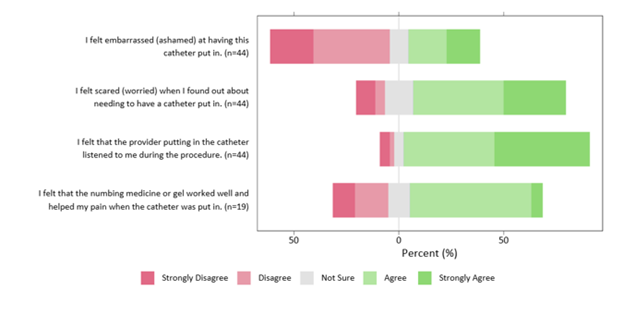General Pediatrics 4
Session: General Pediatrics 4
227 - A Descriptive Study of the Experience of Urinary Catheterization in Children and Adolescents
Sunday, April 27, 2025
8:30am - 10:45am HST
Publication Number: 227.3730
SANDEEP RIAR, Emory University School of Medicine, Johns Creek, GA, United States; Lora A. Bear, Children's Mercy Hospital, Kansas City, MO, United States; Heather Jung, Emory University School of Medicine, Atlanta, GA, United States; Margret Kamel, Emory University School of Medicine, Atlanta, GA, United States; Chris K. Fan, Emory School of Medicine, Atlanta, GA, United States

SANDEEP RIAR, MD (she/her/hers)
Assistant Professor
Emory University School of Medicine
Johns Creek, Georgia, United States
Presenting Author(s)
Background: Urinary catheterization is a common pediatric procedure but it is challenging to counsel patients about it as reported patient experience is based mostly on observation of pre-verbal and nonverbal children. Additionally, this procedure commonly involves topical anesthesia, but some studies suggest no benefit of lidocaine gel over non-anesthetic gel.
Objective: The objective of our study was to describe the self-reported experience of urinary catheterization in pediatric subjects.
Design/Methods: We included 8- to 21-year-old patients undergoing urinary catheterization in the Emergency room or inpatient setting. We used a REDCap survey to collect procedural experience within 2 weeks of the procedure. We measured pain using the Numerical Rating Scale (NRS-11), where 0 is no pain and 10 is the worst pain. Scores of 1-3, 4-6 and 7-10 were classified as mild, moderate, and severe pain, respectively. We excluded patients with developmental delay, altered sensorium, bladder surgery, chronic intermittent catheterization, neurogenic bladder, and didn't speak English.
Results: We recruited 44 patients in the study (mean age 14.9 years, SD 2.7, range 9-19 years), with females (54.5%) and males (45.5%). Ethnicity included Caucasian (56.8%), African American (18.2%), Hispanic (11.4%), Asian (4.6%) and Other (9.1%). More subjects underwent straight catheterization (72.7%) than an indwelling urinary catheter (27.3%). Indications included urinary retention (50.0%), diagnostic reason to help with ultrasound (38.6%) or urinalysis (6.8%) and acute kidney injury (4.6%). Subjects reported more anxiety than embarrassment (Fig 1). Only 19 subjects (43.2%) reported the use of numbing gel and of these 63.2% felt that it helped them. Moderate or severe pain with catheter placement was reported by 75.0% and with removal by 61.0% (Fig 2). With catheter placement, pain duration was reported < 2 minutes by 61.0% and >5 minutes by 9.8%. With catheter removal, pain duration was < 2 minutes in 66.7% of subjects and >5 minutes in 12.1% of subjects. Catheterization was considered more painful than a venipuncture and intravenous (IV) catheter placement by 67.6% and 60.5% subjects respectively (Fig 3).
Conclusion(s): Pediatric patients report significant although mostly brief pain ( < 2 minutes) with urinary catheterization. Many find it more painful than venipuncture and IV catheter placement. Over half of subjects reported lack of use of numbing gel but those who reported its use found it helpful. Our study findings will help providers counsel patients about urinary catheterization and allow its optimization.
Fig 1: Patient experience with urinary catheterization

Fig 2: Pain intensity with urinary catheter placement and removal
.png)
Fig 3: Comparison of pain of urinary catheterization with venipuncture (blood test) and intravenous (IV) catheter placement.
.png)

